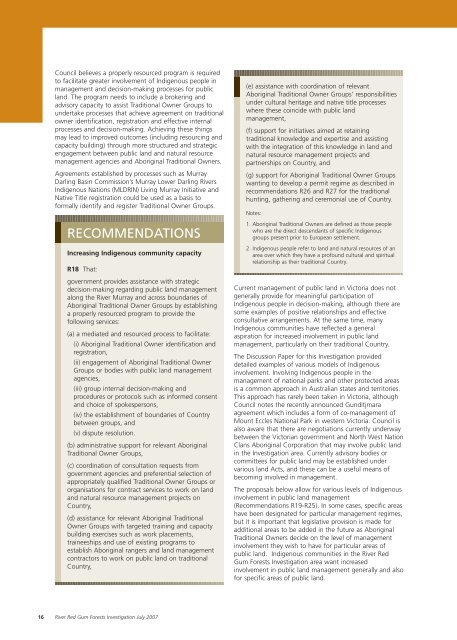Draft Proposals Paper - Full - Victorian Environmental Assessment ...
Draft Proposals Paper - Full - Victorian Environmental Assessment ...
Draft Proposals Paper - Full - Victorian Environmental Assessment ...
Create successful ePaper yourself
Turn your PDF publications into a flip-book with our unique Google optimized e-Paper software.
Council believes a properly resourced program is required<br />
to facilitate greater involvement of Indigenous people in<br />
management and decision-making processes for public<br />
land. The program needs to include a brokering and<br />
advisory capacity to assist Traditional Owner Groups to<br />
undertake processes that achieve agreement on traditional<br />
owner identification, registration and effective internal<br />
processes and decision-making. Achieving these things<br />
may lead to improved outcomes (including resourcing and<br />
capacity building) through more structured and strategic<br />
engagement between public land and natural resource<br />
management agencies and Aboriginal Traditional Owners.<br />
Agreements established by processes such as Murray<br />
Darling Basin Commission’s Murray Lower Darling Rivers<br />
Indigenous Nations (MLDRIN) Living Murray Initiative and<br />
Native Title registration could be used as a basis to<br />
formally identify and register Traditional Owner Groups.<br />
RECOMMENDATIONS<br />
Increasing Indigenous community capacity<br />
R18 That:<br />
government provides assistance with strategic<br />
decision-making regarding public land management<br />
along the River Murray and across boundaries of<br />
Aboriginal Traditional Owner Groups by establishing<br />
a properly resourced program to provide the<br />
following services:<br />
(a) a mediated and resourced process to facilitate:<br />
(i) Aboriginal Traditional Owner identification and<br />
registration,<br />
(ii) engagement of Aboriginal Traditional Owner<br />
Groups or bodies with public land management<br />
agencies,<br />
(iii) group internal decision-making and<br />
procedures or protocols such as informed consent<br />
and choice of spokespersons,<br />
(iv) the establishment of boundaries of Country<br />
between groups, and<br />
(v) dispute resolution.<br />
(b) administrative support for relevant Aboriginal<br />
Traditional Owner Groups,<br />
(c) coordination of consultation requests from<br />
government agencies and preferential selection of<br />
appropriately qualified Traditional Owner Groups or<br />
organisations for contract services to work on land<br />
and natural resource management projects on<br />
Country,<br />
(d) assistance for relevant Aboriginal Traditional<br />
Owner Groups with targeted training and capacity<br />
building exercises such as work placements,<br />
traineeships and use of existing programs to<br />
establish Aboriginal rangers and land management<br />
contractors to work on public land on traditional<br />
Country,<br />
(e) assistance with coordination of relevant<br />
Aboriginal Traditional Owner Groups’ responsibilities<br />
under cultural heritage and native title processes<br />
where these coincide with public land<br />
management,<br />
(f) support for initiatives aimed at retaining<br />
traditional knowledge and expertise and assisting<br />
with the integration of this knowledge in land and<br />
natural resource management projects and<br />
partnerships on Country, and<br />
(g) support for Aboriginal Traditional Owner Groups<br />
wanting to develop a permit regime as described in<br />
recommendations R26 and R27 for the traditional<br />
hunting, gathering and ceremonial use of Country.<br />
Notes:<br />
1. Aboriginal Traditional Owners are defined as those people<br />
who are the direct descendants of specific Indigenous<br />
groups present prior to European settlement.<br />
2. Indigenous people refer to land and natural resources of an<br />
area over which they have a profound cultural and spiritual<br />
relationship as their traditional Country.<br />
Current management of public land in Victoria does not<br />
generally provide for meaningful participation of<br />
Indigenous people in decision-making, although there are<br />
some examples of positive relationships and effective<br />
consultative arrangements. At the same time, many<br />
Indigenous communities have reflected a general<br />
aspiration for increased involvement in public land<br />
management, particularly on their traditional Country.<br />
The Discussion <strong>Paper</strong> for this Investigation provided<br />
detailed examples of various models of Indigenous<br />
involvement. Involving Indigenous people in the<br />
management of national parks and other protected areas<br />
is a common approach in Australian states and territories.<br />
This approach has rarely been taken in Victoria, although<br />
Council notes the recently announced Gunditjmara<br />
agreement which includes a form of co-management of<br />
Mount Eccles National Park in western Victoria. Council is<br />
also aware that there are negotiations currently underway<br />
between the <strong>Victorian</strong> government and North West Nation<br />
Clans Aboriginal Corporation that may involve public land<br />
in the Investigation area. Currently advisory bodies or<br />
committees for public land may be established under<br />
various land Acts, and these can be a useful means of<br />
becoming involved in management.<br />
The proposals below allow for various levels of Indigenous<br />
involvement in public land management<br />
(Recommendations R19-R25). In some cases, specific areas<br />
have been designated for particular management regimes,<br />
but it is important that legislative provision is made for<br />
additional areas to be added in the future as Aboriginal<br />
Traditional Owners decide on the level of management<br />
involvement they wish to have for particular areas of<br />
public land. Indigenous communities in the River Red<br />
Gum Forests Investigation area want increased<br />
involvement in public land management generally and also<br />
for specific areas of public land.<br />
16 River Red Gum Forests Investigation July 2007
















